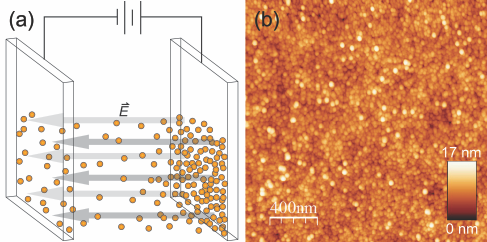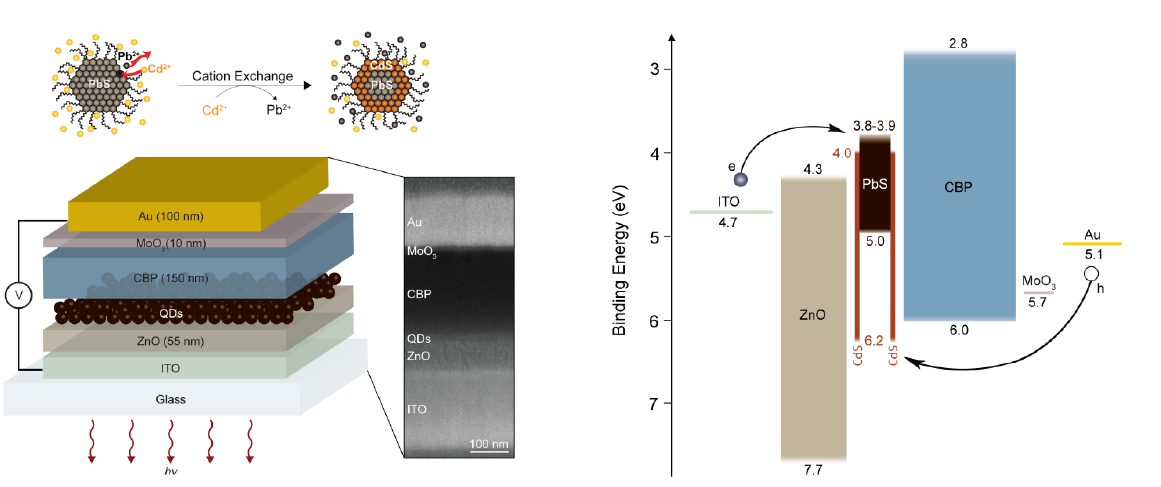Between 2011 and 2013, I conducted research as a PhD student with Professor Vladimir Bulović in the Organic and Nanostructured Laboratory at MIT. While I also dabbled in various project such as fabricating OLEDs on paper and plastic substrates, my research focus was on quantum dot light emitting devices (QD-LEDs). I summarize two related projects here.
Electrophoretic deposition of quantum dots for light emitting devices
(a) Schematic depiction of the electrophoretic deposition process. A voltage applied between two parallel, conducting electrodes spaced 0.4 cm apart drives the deposition of the particles (QDs). (b) AFM topography image of the surface of an electrophoretically deposited QD film with RMS roughness of 2.3 nm.
QD-LEDs are promising options for the next generation of solid state lighting, color displays, and other optoelectronic applications. Overcoating quantum dots (QDs) – semiconducting nanocrystals of CdSe, PbS, or another similar compound – with a wide band-gap “shell” has recently been shown to significantly boost QD-LED performance and yield the most efficient QD-LEDs to date. In this project, I, in collaboration with Dr. Ronny Costi, a post-doc in the lab, invented a technique to electrophoretically deposit (EPD) CdSe/ZnS core-shell QDs to make bright, efficient QD-LEDs. QD-LEDs conventionally utilize a QD film that is deposited via spin-casting, a reliable but highly unscalable technique for the deposition of thin, smooth films of QDs for QD-LED applications. Potential advantages of EPD include the ability for deposition onto a variety of substrate shapes and more energetically favorable QD packing. We were able to create devices made with EPD QD films that exhibit peak efficiencies comparable to those of devices with a spun-cast QD layer and turn-on voltages surprisingly lower than the optical band-gap of the QDs. These results suggest that EPD is a viable alternative to spin-casting for the processing of QD-LEDs.
Near-infrared quantum dot LEDs
In collaboration with a fellow graduate student, Geoffrey Supran, I next explored the role of core-shell QDs in creating bright, efficient LEDs in the near-infrared (λ > 1 µm) regime. We designed and fabricated infrared QD-LEDs with record brightness and efficiencies by using QDs in which lead sulfide (PbS) cores were overcoated with a cadmium sulfide (CdS) shell. In-situ photoluminescence quantum yield measurements confirmed that the QD shell plays a significant role in shielding the emissive QD core from external quenching mechanisms.
publications
-
Fabrication and Optimization of Light Emitting Devices with Core-Shell Quantum Dots
Katherine Wei Song
Master's Thesis (MIT), 2013
Quantum dot light emitting devices (QD-LEDs) are promising options for the next generation of solid state lighting, color displays, and other optoelectronic applications. Overcoating quantum dots (QDs) – semiconducting nanocrystals of CdSe, PbS, or another similar compound – with a wide band-gap "shell" has recently been shown to significantly boost QD-LED performance and yield the most efficient QD-LEDs to date. This thesis studies fabrication techniques to make bright, efficient QD-LEDs with these "core-shell" QDs. The first part studies the electrophoretic deposition (EPD) of CdSe/ZnS QDs. QD-LEDs conventionally utilize a QD film that is deposited via spin-casting, a reliable but highly unscalable technique for the deposition of thin, smooth films of QDs for QD-LED applications. Potential advantages of EPD include the ability for deposition onto a variety of substrate shapes and more energetically favorable QD packing. Devices made with EPD QD films exhibit peak efficiencies comparable to those of devices with a spun-cast QD layer and turn-on voltages surprisingly lower than the optical band-gap of the QDs. These results suggest that EPD is a viable alternative to spin-casting for the processing of QD-LEDs. The second part of this thesis explores the role of core-shell QDs in creating bright, efficient LEDs in the near-infrared (λ > 1 µm) regime. Infrared QD-LEDs with record brightness and efficiencies are obtained by using QDs in which lead sulfide (PbS) cores are overcoated with a cadmium sulfide (CdS) shell. In situ photoluminescence quantum yield measurements confirm that the QD shell plays a significant role in shielding the emissive QD core from external quenching mechanisms.
-
Deposition of Semiconductor Nanocrystals for Light Emitting Devices
Vladimir Bulović, Katherine Wei Song, and Ronny Costi
US Patent US 9,472,723 B2, Oct 2016
A method of depositing semiconductor nanocrystals on a surface can include applying a voltage to the nanocrystals.
-
QLEDs for displays and solid-state lighting
Geoffrey J. Supran, Yasuhiro Shirasaki, Katherine W. Song, Jean-Michel Caruge, Peter T. Kazlas, Seth Coe-Sullivan, Trisha L. Andrew, Moungi G. Bawendi, and Vladimir Bulović
MRS Bulletin, Sep 2013
The mainstream commercialization of colloidal quantum dots (QDs) for light-emitting applications has begun: Sony televisions emitting QD-enhanced colors are now on sale. The bright and uniquely size-tunable colors of solution-processable semiconducting QDs highlight the potential of electroluminescent QD light-emitting devices (QLEDs) for use in energy-efficient, high-color-quality thin-film display and solid-state lighting applications. Indeed, this year’s report of record-efficiency electrically driven QLEDs rivaling the most efficient molecular organic LEDs, together with the emergence of full-color QLED displays, foreshadow QD technologies that will transcend the optically excited QD-enhanced products already available. In this article, we discuss the key advantages of using QDs as luminophores in LEDs and outline the 19-year evolution of four types of QLEDs that have seen efficiencies rise from less than 0.01% to 18%. With an emphasis on the latest advances, we identify the key scientific and technological challenges facing the commercialization of QLEDs. A quantitative analysis, based on published small-scale synthetic procedures, allows us to estimate the material costs of QDs typical in light-emitting applications when produced in large quantities and to assess their commercial viability.
-
Electrophoretic Deposition of CdSe/ZnS Quantum Dots for Light-Emitting Devices
Katherine W. Song, Ronny Costi, and Vladimir Bulović
Advanced Materials, Mar 2013
The electrophoretic deposition of thin films of colloidal quantum dots is an alternative to spin-casting and printing for large-area, high-throughput processing of quantum-dot (QD) optoelectronics. In this study, QD light-emitting diodes (QD-LEDs) fabricated with electrophoretically deposited films of CdSe/ZnS core/shell QDs are demonstrated for the first time.
-
-
Near-Infrared Light Emitting Device using Semiconductor Nanocrystals
Geoffrey J. S. Supran, Katherine W. Song, Gyuweon Hwang, Raoul Emile Correa, Yasuhiro Shirasaki, Moungi G. Bawendi, Vladimir Bulovic, and Jennifer Scherer
US Patent US 9,935,240 B2, Apr 2018
A near-infrared light emitting device can include semiconductor nanocrystals that emit at wavelengths beyond 1 μm. The semiconductor nanocrystals can include a core and an overcoating on a surface of the core.


